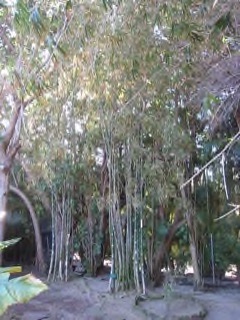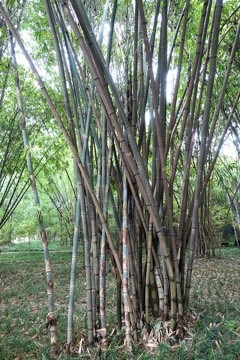 |
|
wikimedia.org Matthieu Sontag (User:Mirgolth) |
 |
| wikimedia.org Daderot |
Translate this page:
Summary
Physical Characteristics

 Gigantochloa albociliata is an evergreen Bamboo growing to 12 m (39ft) by 4 m (13ft) at a fast rate.
Gigantochloa albociliata is an evergreen Bamboo growing to 12 m (39ft) by 4 m (13ft) at a fast rate.
See above for USDA hardiness. It is hardy to UK zone 10. The flowers are pollinated by Wind.
Suitable for: light (sandy), medium (loamy) and heavy (clay) soils, prefers well-drained soil and can grow in nutritionally poor soil. Suitable pH: mildly acid and neutral soils. It can grow in semi-shade (light woodland) or no shade. It prefers moist soil.
UK Hardiness Map
US Hardiness Map
Synonyms
Dendrocalamus albociliatus (Munro) J.L.Sun Oxytenanthera albociliata Munro Pseudotenanthera albociliata (Munro) R.B.Majumdar Pseudoxytenanthera albociliata (Munro) R.B.Majumdar Pseudoxytenanthera albociliata (Munro) T.Q.Nguyen
Plant Habitats
Edible Uses
Edible Parts: Shoots
Edible Uses:
Young shoots are eaten as a vegetable[310 ].
References More on Edible Uses
Medicinal Uses
Plants For A Future can not take any responsibility for any adverse effects from the use of plants. Always seek advice from a professional before using a plant medicinally.
None known
References More on Medicinal Uses
The Bookshop: Edible Plant Books
Our Latest books on Perennial Plants For Food Forests and Permaculture Gardens in paperback or digital formats.

Edible Tropical Plants
Food Forest Plants for Hotter Conditions: 250+ Plants For Tropical Food Forests & Permaculture Gardens.
More

Edible Temperate Plants
Plants for Your Food Forest: 500 Plants for Temperate Food Forests & Permaculture Gardens.
More

More Books
PFAF have eight books available in paperback and digital formats. Browse the shop for more information.
Shop Now
Other Uses
Biomass Fencing Fodder Furniture Paper Plant support Wood
The woody culms are used in light construction (cottage walls, frames of thatched roofs), as trellises for climbing vegetables, for fence construction (typical in western part of central Thailand), tool handles (basal culm parts), furniture (with proper firing culms can be bent like rattan), woven wares and as raw material for paper and board[310 ].
Special Uses
Carbon Farming Food Forest
References More on Other Uses
Cultivation details
Fodder: Bank Industrial Crop: Biomass Management: Managed Multistem Regional Crop
Gigantochloa albociliata grows naturally in the dry tropical mixed forest at low to medium elevations. It is found in areas where the mean annual rainfall is in the range of 800 - 1,300mm, and the mean annual temperature is around 28°c[310 ].. Succeeds in well-drained soils of poor to medium fertility[310 ]. Annual culm production in natural stands is 9 - 46 tonnes per hectare[310 ]. A 6 year old clump raised from a rhizome cutting produced 27 culms with an average height of 10.5 metres (ranging from 5 - 16 metres), with an average diameter of 20mm (ranging from 10 - 30mm). A mature clump in a natural stand in Thailand can bear 50 - 60 culms[310 ]. Bamboos have an interesting method of growth. Each plant produces a number of new stems annually - these stems grow to their maximum height in their first year of growth, subsequent growth in the stem being limited to the production of new side branches and leaves. In the case of some mature tropical species the new stem could be as much as 30 metres tall, with daily increases in height of 30cm or more during their peak growth time. This makes them some of the fastest-growing species in the world[K ]. Bamboos in general are usually monocarpic, living for many years before flowering, then flowering and seeding profusely for a period of 1 - 3 years before usually dying. This pattern can vary - sometimes flowering is sporadic, with plants flowering annually and not dying; at other times it is gregarious with all the plants in a specific species coming into flower at the same time. This species flowers both sporadically and gregariously. In Thailand, sporadic flowering is common whilst a flowering cycle of 30 years has been reported from Assam [310 , 361 ]. Seeds from sporadic flowering are often not fertile[361 ]. Normally, 3-year-old culms are harvested in a 3-year felling cycle, usually at the end of the dry season. Culms used for furniture need to be flexible and so are harvested when 2 years old, and cut close to the ground (the basal 1 - 2 metres is the most useful section because of the thicker wall), because 3-year-old culms are too stiff to bend and younger culms normally shrink during firing. Culms harvested at the end of the dry season are more resistant to borer attack[310 ]. Young shoots for food are harvested in the rainy season[310 ]. Traditional and chemical treatments are employed to preserve culms. Traditionally, culms are submerged in running water for 10 - 20 days. The culms are cleaned by rubbing with coconut husks or rice straw dipped in wet wood ash for a shiny surface, otherwise sandpaper is used. Chemical treatments include boiling the culms for 15 - 20 minutes at 95°c in a solution of 0.2% sodium carbonate or 0.1% calcium hydroxide, or at 80°c in a 0.3% copper sulphate solution. After the treatments, culms are washed with water, dried in the sun for 1 - 2 days, and stored in well ventilated rooms[310 ].
Carbon Farming
-
Fodder: Bank
Fodder banks are plantings of high-quality fodder species. Their goal is to maintain healthy productive animals. They can be utilized all year, but are designed to bridge the forage scarcity of annual dry seasons. Fodder bank plants are usually trees or shrubs, and often legumes. The relatively deep roots of these woody perennials allow them to reach soil nutrients and moisture not available to grasses and herbaceous plants.
-
Industrial Crop: Biomass
Three broad categories: bamboos, resprouting woody plants, and giant grasses. uses include: protein, materials (paper, building materials, fibers, biochar etc.), chemicals (biobased chemicals), energy - biofuels
-
Management: Managed Multistem
Regularly removing some multiple stems. A non-A non-destructive management systems maintaining the soil organic carbon.
-
Regional Crop
These crops have been domesticated and cultivated regionally but have not been adopted elsewhere and are typically not traded globally, Examples in this broad category include perennial cottons and many nuts and staple fruits.
References Carbon Farming Information and Carbon Sequestration Information
Temperature Converter
Type a value in the Celsius field to convert the value to Fahrenheit:
Fahrenheit:
The PFAF Bookshop
Plants For A Future have a number of books available in paperback and digital form. Book titles include Edible Plants, Edible Perennials, Edible Trees,Edible Shrubs, Woodland Gardening, and Temperate Food Forest Plants. Our new book is Food Forest Plants For Hotter Conditions (Tropical and Sub-Tropical).
Shop Now
Plant Propagation
Seed - Rhizome cuttings are planted, using portions of the culm 30 - 50cm long. For small-scale planting seedlings are also collected from the forest.
Other Names
If available other names are mentioned here
Bai mao ju zhu, Laix, Maihoushuan, Phai khai, Phai-rai, Phai-ruaklek, Russei khlei, Wa-hpyu-ka-le
Native Range
TEMPERATE ASIA: Yunnan Sheng (south),China. TROPICAL ASIA: Bangladesh (east), India, Assam, Meghalaya, Tripura, Myanmar, Thailand,
Weed Potential
Right plant wrong place. We are currently updating this section.
Please note that a plant may be invasive in one area but may not in your area so it's worth checking.
None Known
Conservation Status
IUCN Red List of Threatened Plants Status : This taxon has not yet been assessed

Growth: S = slow M = medium F = fast. Soil: L = light (sandy) M = medium H = heavy (clay). pH: A = acid N = neutral B = basic (alkaline). Shade: F = full shade S = semi-shade N = no shade. Moisture: D = dry M = Moist We = wet Wa = water.
Now available:
Food Forest Plants for Mediterranean Conditions
350+ Perennial Plants For Mediterranean and Drier Food Forests and Permaculture Gardens.
[Paperback and eBook]
This is the third in Plants For A Future's series of plant guides for food forests tailored to
specific climate zones. Following volumes on temperate and tropical ecosystems, this book focuses
on species suited to Mediterranean conditions—regions with hot, dry summers and cool, wet winters,
often facing the added challenge of climate change.
Read More
Expert comment
Author
(Munro) Kurz
Botanical References
Links / References
For a list of references used on this page please go here
A special thanks to Ken Fern for some of the information used on this page.
Readers comment
| Add a comment |
|
If you have important information about this plant that may help other users please add a comment or link below. Only comments or links that are felt to be directly relevant to a plant will be included. If you think a comment/link or information contained on this page is inaccurate or misleading we would welcome your feedback at [email protected]. If you have questions about a plant please use the Forum on this website as we do not have the resources to answer questions ourselves.
* Please note: the comments by website users are not necessarily those held by PFAF and may give misleading or inaccurate information.
To leave a comment please Register or login here All comments need to be approved so will not appear immediately.
|
Subject : Gigantochloa albociliata
|
|
|
|